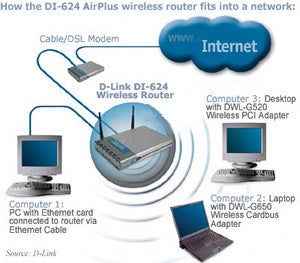Because of the continuing draft status of the 802.11g specification, not every vendor is jumping on this particular high-speed 2.4GHz product bandwagon. Several companies, however, are embracing 802.11g in an early iteration and D-Link is one of the more notable among them. The DI-624 AirPlus Xtreme G Wireless Router is D-Link’s entry into the growing market of 802.11g-compatible WLAN devices.
If you’ve worked with D-Link WLAN products before, this one will be familiar to you, as the DI-624’s hardware and software configuration are very much like that of previous products in the D-Link family. For example, the DI-624 uses D-Link’s signature (and very competent) interface, which I like to call 5&5 — five buttons down the left margin and five tabs across the top.
Unfortunately, the router exhibits an annoying characteristic of its predecessors; specifically, almost every configuration change results in an abrupt and immediate reboot of the unit. This is a huge hassle, especially when you’re first setting up the router and modifying most of its settings for the first time, or if you are in an environment where you make frequent configuration changes. If this is you, be duly warned. If not, this idiosyncrasy probably isn’t a major issue, but it would still be nice if D-Link would allow you to queue up multiple configuration changes and then initiate them all with a single reboot.
A potentially more serious issue was that feature that provides e-mail notification about attempted attacks and other router events simply didn’t work.
Because there’s not much else new here from a features or interface perspective, the focus inevitably turns to issues of performance.
Aside from its infinitely superior interface, the wireless setup of the DI-624 is considerably more straightforward than the Buffalo AirStation G54. For starters, unlike the AirStation, the DI-624 doesn’t offer multiple WLAN modes of operation to accommodate various scenarios of "b" and "g" clients.

Running performance tests against the DI-624 with the company’s companion 802.11g DWL-G650 High-Speed 2.4 GHz Wireless CardBus Adapter using NetIQ’s Chariot revealed an acceptable and predictably linear performance curve as distance from the router grew.
At close range (10 feet or less), the DI-624 delivered over 14 Mbps of throughput — clearly not in the league of 802.11a, but easily twice that of 802.11b and also consistent with what we’ve come to expect from the early generation of draft 802.11g products. As I moved further away from the router, performance degraded substantially (but not catastrophically) to the point that at a distance of 100 feet, throughput was still a healthy 9 Mbps. Streaming and response time tests were consistent and commensurate as well, and as is often the case, enabling 128-bit Wired Equivalent Privacy (WEP) encryption did not exact any performance penalty.
Of course, running in a homogenous 802.11g environment is ideal, but it’s an unlikely scenario, at least for the foreseeable future, due to the large installed base of 802.11b-based hardware. Someone who is looking for better performance than 802.11b but doesn’t have "legacy" hardware is as likely to go with 802.11a.
Therefore, the next step was to associate an 802.11b client (in this case, a D-Link DWL-650+) with the DI-624, and re-run the test between the 802.11g client and the router. In this scenario, the throughput dropped from 14.64 to 10.75, a decrease of about 25 percent. This was actually better than expected, owing that an 802.11b association can often cause a performance drop of as high as 40 percent.
Next, I ran a performance test with NetIQ‘s Chariot using both an 802.11b and an 802.11g client simultaneously. This definitely took the wind out of the 802.11g sails. Both cards turned in 802.11b-like throughput numbers, in the neighborhood of 3 Mbps. In some cases though, the 802.11b card actually outperformed the 802.11g card, albeit by a slim margin.
According to D-Link, this phenomenon was a result of the requirements of the current 802.11g specification (draft), which prioritizes 802.11b traffic in mixed mode to ensure that b clients will get their share of the available bandwidth.
Late in the review process, D-Link provided me with an updated version of the DI-624 firmware which they said would ameliorate the issue to a great extent (while still remaining within specification) and allow 802.11g clients to perform better when 802.11b devices are transmitting on the same router, though I didn’t have the opportunity to verify that this was the case.
Naturally, any product based on a less-than-final Wireless Local Area Network (WLAN) specification like 802.11g is going to be an unknown quantity to some extent, and the DI-624 will doubtless evolve as the specification does.
Despite this, the D-Link DWL-624 lives up to the company’s reputation for WLAN products that deliver solid features and performance, and it displays considerably more polish than the Buffalo AirStation G54 previously evaluated. As such, in my estimation the DI-624 at $149 is as solid a foundation as any upon which to build a current and/or future 802.11g network.
Adapted from 802.11-Planet.com.

